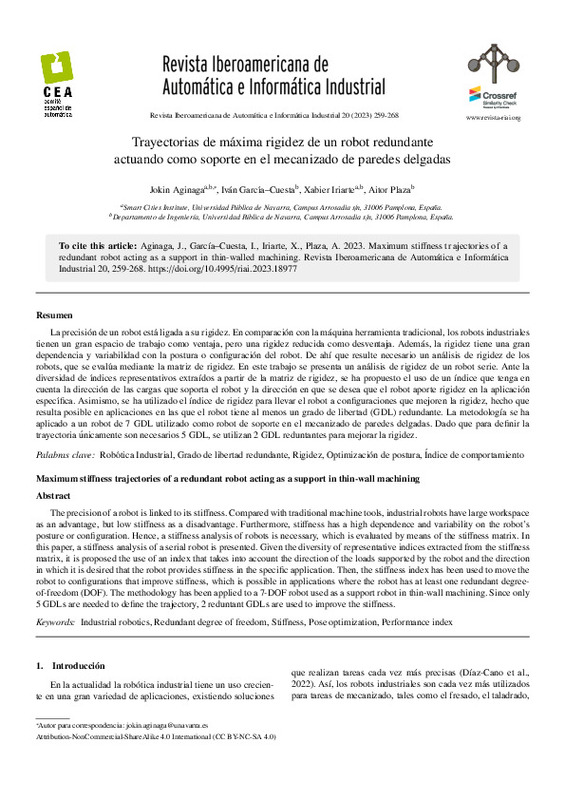Aginaga, J., Zabalza, I., Altuzarra, O., Nájera, J., 2012. Improving static stiffness of the 6-rus parallel manipulator using inverse singularities. Robotics and Computer Integrated Manufacturing 28, 458-471. https://doi.org/10.1016/j.rcim.2012.02.003
Angeles, J., 2010. On the nature of the cartesian stiffness matrix. Ingeniería Mecánica 3 (5), 163-170.
Azulay, H., Mahmoodi, M., Zhao, R., Mills, J. K., Benhabib, B., 2014. Comparative analysis of a new 3×PPRS parallel kinematic mechanism. Robotics and Computer-Integrated Manufacturing 30 (4), 369-378. https://doi.org/10.1016/j.rcim.2013.12.003
[+]
Aginaga, J., Zabalza, I., Altuzarra, O., Nájera, J., 2012. Improving static stiffness of the 6-rus parallel manipulator using inverse singularities. Robotics and Computer Integrated Manufacturing 28, 458-471. https://doi.org/10.1016/j.rcim.2012.02.003
Angeles, J., 2010. On the nature of the cartesian stiffness matrix. Ingeniería Mecánica 3 (5), 163-170.
Azulay, H., Mahmoodi, M., Zhao, R., Mills, J. K., Benhabib, B., 2014. Comparative analysis of a new 3×PPRS parallel kinematic mechanism. Robotics and Computer-Integrated Manufacturing 30 (4), 369-378. https://doi.org/10.1016/j.rcim.2013.12.003
Bu, Y., Liao, W., Tian, W., Zhang, J., Zhang, L., 2017. Stiffness analysis and optimization in robotic drilling application. Precision Engineering 49, 388- 400. https://doi.org/10.1016/j.precisioneng.2017.04.001
Chen, C., Peng, F., Yan, R., Li, Y., Wei, D., Fan, Z., Tang, X., Zhu, Z., 2019. Stiffness performance index based posture and feed orientation optimization in robotic milling process. Robotics and Computer-Integrated Manufacturing 55, 29-40. https://doi.org/10.1016/j.rcim.2018.07.003
Cvitanic, T., Nguyen, V., Melkote, S., 2020. Pose optimization in robotic machining usieng static and dynamic stiffness models. Robotics and Computer Integrated Manufacturing 66, 101992. https://doi.org/10.1016/j.rcim.2020.101992
Díaz-Cano, I., Quintana, F. M., Galindo, P. L., Morgado-Estevez, A., 2022. Calibraci'on ojo a mano de un brazo robótico industrial con cámaras 3d de luz estructurada. Revista Iberoamerica de Automática e Informática Industrial 19 (2), 154-163. https://doi.org/10.4995/riai.2021.16054
Denavit, J., Hartenberg, R. S., 1955. A kinematic notation for lower-pair mechanisms based on matrices. Journal of Applied Mechanics 22 (2), 215-221. https://doi.org/10.1115/1.4011045
Guo, Y., Dong, H., Ke, Y., 2015. Stiffness-oriented posture optimization in robotic machining applications. Robotics and Computer-Integrated Manufacturing 35, 69-76. https://doi.org/10.1016/j.rcim.2015.02.006
Herranz, S., Campa, F. J., de Lacalle, L. N. L., Rivero, A., Lamikiz, A., Ukar, E., Sánchez, J. A., Bravo, U., 2005. The milling of airframe components with low rigidity: A general approach to avoid static and dynamic problems. Proceedings of the Institution of Mechanical Engineers, Part B: Journal of Engineering Manufacture 219 (11), 789-801. https://doi.org/10.1243/095440505X32742
Léger, J., Angeles, J., 2016. Off-line programming of six-axis robots for optimum five-dimensional tasks. Mechanism and Machine Theory 100, 155-169. https://doi.org/10.1016/j.mechmachtheory.2016.01.015
Li, M., Hu, X., Du, L., Bao, S., Yuan, J., 2022. Stiffness modeling of redundant robots with large load capacity and workspace. In: 2022 IEEE International Conference on Real-time Computing and Robotics (RCAR). pp. 407-412. https://doi.org/10.1109/RCAR54675.2022.9872192
Liao, Z.-Y., Wang, Q.-H., Xie, H.-L., Li, J.-R., Zhou, X.-F., Pan, T.-H., 2022. Optimization of robot posture and workpiece setup in robotic milling with stiffness threshold. IEEE/ASME Transactions on Mechatronics 27 (1), 582-593. https://doi.org/10.1109/TMECH.2021.3068599
Lin, J., Ye, C., Yang, J., Zhao, H., Ding, H., Luo, M., 2022. Contour error-based optimization of the end-effector pose of a 6 degree-of-freedom serial robot in milling operation. Robotics and Computer-Integrated Manufacturing 73, 102257. https://doi.org/10.1016/j.rcim.2021.102257
Mohammadi, Y., Ahmadi, K., 2022. In-process frequency response function measurement for robotic milling. Experimental Techniques, 1747-1567. https://doi.org/10.1007/s40799-022-00590-5
Ozturk, E., Barrios, A., Sun, C., Rajabi, S., Munoa, J., 2018. Robotic assisted milling for increased productivity. CIRP Annals 67 (1), 427-430. https://doi.org/10.1016/j.cirp.2018.04.031
Qintao, C., Jizhi, Y., Shen, Y., Pengyu, L., 2019. Optimization of comprehensive stiffness performance index for industrial robot in milling process. In: 2019 IEEE 9th Annual International Conference on CYBER Technology in Automation, Control, and Intelligent Systems (CYBER). pp. 609-614. https://doi.org/10.1109/CYBER46603.2019.9066502
Rao, A. B. K., Saha, S. K., Rao, P. V. M., 2005. Stiffness analysis of hexaslide machine tools. Advanced Robotics 19 (6), 671-693. https://doi.org/10.1163/1568553054255673
Shimizu, M., Kakuya, H., Yoon,W.-K., Kitagaki, K., Kosuge, K., 2008. Analytical inverse kinematic computation for 7-dof redundant manipulators with joint limits and its application to redundancy resolution. IEEE Transactions on Robotics 24 (5), 1131-1142. https://doi.org/10.1109/TRO.2008.2003266
Song, G., Su, S., Li, Y., Zhao, X., Du, H., Han, J., Zhao, Y., 2021. A closed-loop framework for the inverse kinematics of the 7 degrees of freedom manipulator. Robotica 39 (4), 572-581. https://doi.org/10.1017/S0263574720000582
Torres, R., González, S., Elguea, I., Aginaga, J., Iriarte, X., Agirre, N., Inziarte, I., 2020. Robotic assisted thin-wall machining with a collaborative robot. In: 2020 IEEE 16th International Conference on Automation Science and Engineering (CASE). pp. 1505-1508. https://doi.org/10.1109/CASE48305.2020.9216864
Tsai, L. W., 1999. Robot Analysis: the Mechanics of Serial and Parallel Manipulators. John Willey and sons, New York.
Xue, X., Zhang, C., Chen, Q., Xu, X., 2022. The posture optimization method based on deformation index in robotic milling process. The International Journal of Advanced Manufacturing Technology 121 (7), 4999-5014. https://doi.org/10.1007/s00170-022-09745-5
Zaplana, I., Claret, J. A., Basanez, L., 2018. An'alisis cinemático de robots manipuladores redundantes: aplicación a los robots Kuka LWR 4+ y ABB Yumi. Revista Iberoamerica de Automática e Informática Industrial 15 (2), 192-202. https://doi.org/10.4995/riai.2017.8822
Zaplana, I., Hadfield, H., Lasenby, J., 2022. Closed-form solutions for the inverse kinematics of serial robots using conformal geometric algebra. Mechanism and Machine Theory 173, 104835. https://doi.org/10.1016/j.mechmachtheory.2022.104835
Zhang, H., Cheng, G., Chen, S., Guo, F., Shan, X., 2018. Stiffness modeling and performance evaluation of 2(3hus +s) parallel manipulator. In: 2018 3rd International Conference on Advanced Robotics and Mechatronics (ICARM). pp. 456-461. https://doi.org/10.1109/ICARM.2018.8610777
Zhao, J., Duan, Y., Xie, B., Zhang, Z., 2021. Fsw robot system dimensional optimization and trajectory planning based on soft stiffness indices. Journal of Manufacturing Processes 63, 88-97, trends in Intelligentizing Robotic Welding Processes. https://doi.org/10.1016/j.jmapro.2020.05.004
Zhao, X., Tao, B., Qian, L., Yang, Y., Ding, H., 2020. Asymmetrical nonlinear impedance control for dual robotic machining of thin-walled workpieces. Robotics and Computer-Integrated Manufacturing 63, 101889. https://doi.org/10.1016/j.rcim.2019.101889
[-]








